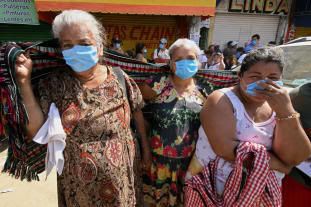You’ll recall that in late October and early November the state of Tabasco in Mexico had huge floods.

Women in Villahermosa covered their noses on Sunday because of the stench from the receding flood waters.
The flood, which was very briefly noted in the traditional media, and has faded from the traditional media.
And now there is a serious concern about an outbreak of dengue.
AFP reports
Mexican health authorities Saturday began aerial spraying of southern Tabasco state, including its capital Villahermosa, after massive floods earlier this month raised a bumper crop of mosquitos that can spread dengue.
“The job will cover the 10,000 hectares (24,700 acres) of Villahermosa and surroundings and will be complemented with ground fumigation of streets and empty lots and homes,” the Health Ministry said in a statement.
The fumigation operation, it added, will be carried out in three phases of three days each, ending in early December.
Dengue and dengue hemorrhagic fever (DHF) are acute febrile diseases, found in the tropics and Africa, with a geographical spread similar to malaria. They are spread to humans by a type of mosquito. If this spread hits America then precautionary measures must be put in place, so companies like Mosquito Authority of Hilton Head may be used to help protect homes, businesses, etc. to cover all bases.
I have personal experience with Dengue. It arrives without warning as an enormous fever that lasts for days, bringing delirium, dehydration, and a falling platelet count. In second or third exposures to the fever, there is a danger of massive internal hemorrhage and death.
The floods in Tabasco, which has 2 million residents, displaced more than half of the population. About 70,000 people ended up in shelters. Another 20,000 or so ended up living on their roofs. Many others fled to nearby places with high ground. Indigenous people in the interior found themselves trapped on islands in the flood. All of the crops were destroyed. Oil production was halted. The flood created a colossal, smelly mosquito habitat. And now, inevitably, this.
Aid appears to be arriving in Tabasco for the beleaguered population. But there are significant problems in getting aid to people who need it. According to the Houston Chronicle
Thousands of tons of food, drinking water, clothing and medicines are flowing into the state capital of Villahermosa. Government cash in outright gifts and low-interest loans looms. Volunteers, Mexican and foreign, have joined local, state and federal workers in wading into stricken communities.
But it’s not all blue skies.
In a state where federal, state and local officials now belong to bitterly competing political parties, the aid is carrying a lot of political baggage. And too many of the supplies remain stuck in Villahermosa warehouses or in city halls in outlying areas, with some hamlets receiving little or nothing at all.
“Maybe help is getting to people in the capital, but out here we are abandoned,” said Eleuterio de la Cruz, an elected official in Oxiacaque, a Chontal Indian community 20 miles from Villahermosa that sits atop one of Tabasco’s richest oil fields. “We understand there is a lot of aid coming, but is not getting here.”
In other words, many, many people who were devastated by the flood are not receiving the aid they still desperately need, even though the aid may be as close as 20 miles away. Is this Mexico’s version of Katrina? And where are the reports showing whether charitable donations from the US and Mexico and other countries are reaching their intended beneficiaries?
And, of course, simmering in the background is a dispute about whether the gigantic damage from the floods could have been averted. And whether and how fault should be assigned. The WaPo is reporting that the extent of flooding may have been increased by political graft
Long before the devastating flooding this month in the state of Tabasco, Mexico’s behemoth state-run oil company, Petróleos Mexicanos, was pouring hundreds of thousands of dollars into local government coffers for flood abatement projects.
From 1997 to 2001, at least $3 million was donated to build dikes, raise levees and move poor residents from low-lying areas, according to analysts and independent investigators. But a crescendo of questions about whether the oil money was ever used for the intended projects is raising the possibility that corruption and incompetence might have played as much of a role in the tragedy as historically torrential rains.
The Saint Tomas Association, a nongovernmental organization, has said there was no evidence that two previous Tabasco governors — Manuel Andrade Díaz and Roberto Madrazo Pintado, who also was a 2006 presidential candidate — spent the oil money on flood projects.
And so, the suffering in Tabasco continues. And it may even increase with an epidemic of mosquito borne disease. The picture of this disaster is ugly. And it is not over yet.
Obviously, giving more aid, giving more money is not a solution at this point to the problem. There is no assurance that aid will reach those who need it. What’s needed now is pressure to have the aid distributed.
Please consider writing or calling the Mexican Consulate near you to urge prompt distribution of aid in Tabasco to those who need it. Here is a list of phone numbers and addresses.

5 comments
Skip to comment form
And let’s not forget Bangladesh and the massive after effects there as well as they recover.
Between the two events, how many Climate Crisis refugees have been created? How many more are to come, both from storms that have been pumped up by warming….and by things like crop failures, lack of drinking water, loss of industry due to lack of water…and on and on.
How will the world deal with these refugees?
Especially a world as divided as ours.
why is it so hard to do the right thing?